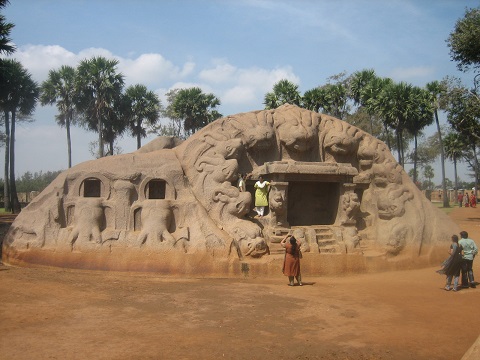Mamallapuram – The Workshop of the Pallavas
Yali Mandapa

This unique rock-cut shrine is situated adjacent to the Atiranachanda cave-temple. In its style and architecture, it differs from all other cave-temples of Mamallapuram. This east-facing shrine is in form of a small mandapa, measuring 6 feet x 4 feet, excavated at a height of about 6 feet above the ground. It can be raised with a flight of four steps.

The mandapa is projected forward and supported on two pillars. The pillars have rearing lion bases, with is a rider above the lion. Two niches are excavated on either side of this cell, . Around these is carved a semi-circle decorated with vyala heads, total of eleven heads in number. On the evidence of these vyala heads, it was generally assumed that the shrine was dedicated to Durga, lion being her mount. However, with no image found inside the mandapa, and no supporting inscription describing the dedication, its association with Durga is on flimsy ground.


Two elephant heads carrying howdahs on their back are carved on the southern side of this Yali Mandapa, sharing the same boulder. The howdahs are in form of a cavity in the rock, on the back wall of which an image is engraved. In between these two elephants is a flag post. Srinivasan1 tells that the image, on the back wall, is shown with four hands and holding what appears to be a vajra or shakti. This led him to suggest that the deity might be representing Indra or Skanda as elephant is the mount of both. This further led him to suggest that the this mandapa was a utsava-mandapa, used during the popular Indra festival. Processional deities were brought and placed here where the king watched the festivities. He points to an inscription, found in vicinity, which referred this place as Tiru-veluchchil, meaning where divine processions are conducted.
To the south of the elephants, there is a rough carving of a horse or pony. To the north of the Yali-mandapa, there is a seated lion with a cavity in its torso. Based upon the similarity of this seated lion sculpture with that of the similar structure in the Shore Temple, Nagaswamy2 is of opinion that this mandapa was dedicated to Durga. The two images, on the back wall of the howdahs, are of the celestial attendants of the goddess. He states that presence of a horse and a lion is similar to the present practice of putting these animals in terracotta medium near Durga shrines.

Fergusson3 takes this Yali-mandapa as a descendant of the Tiger Cave in Orissa.
1 Srinivasan, K R (1964). Cave-Temples of the Pallavas. Archaeological Survey of India. New Delhi. pp 182-83
2 Nagaswamy, R (2008). Mahabalipuram. Oxford University Press. New Delhi. ISBN 9780198071273. pp 37-38
3 Fergusson, James. History of Indian and Eastern Architecture. p 342


I see these caves and sculptures for the first time. Nice. Thanks.
nice picture thanks to sharing